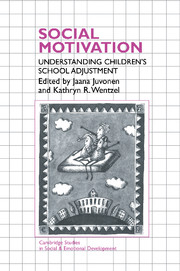Book contents
- Frontmatter
- Contents
- Contributors
- Preface
- Foreword
- 1 Introduction: New perspectives on motivation at school
- Part I Social motivation: Perspectives on self
- 2 Teacher and classmate influences on scholastic motivation, self-esteem, and level of voice in adolescents
- 3 Self-presentation tactics promoting teacher and peer approval: The function of excuses and other clever explanations
- 4 Social self-discrepancy: A theory relating peer relations problems and school maladjustment
- 5 Motivational approaches to aggression within the context of peer relationships
- 6 Motivational opportunities and obstacles associated with social responsibility and caring behavior in school contexts
- 7 Modeling and self-efficacy influences on children's development of self-regulation
- 8 Social motivation: Goals and social-cognitive processes. A comment
- Part II Social motivation: Perspectives on relationships
- Author index
- Subject index
2 - Teacher and classmate influences on scholastic motivation, self-esteem, and level of voice in adolescents
Published online by Cambridge University Press: 22 October 2009
- Frontmatter
- Contents
- Contributors
- Preface
- Foreword
- 1 Introduction: New perspectives on motivation at school
- Part I Social motivation: Perspectives on self
- 2 Teacher and classmate influences on scholastic motivation, self-esteem, and level of voice in adolescents
- 3 Self-presentation tactics promoting teacher and peer approval: The function of excuses and other clever explanations
- 4 Social self-discrepancy: A theory relating peer relations problems and school maladjustment
- 5 Motivational approaches to aggression within the context of peer relationships
- 6 Motivational opportunities and obstacles associated with social responsibility and caring behavior in school contexts
- 7 Modeling and self-efficacy influences on children's development of self-regulation
- 8 Social motivation: Goals and social-cognitive processes. A comment
- Part II Social motivation: Perspectives on relationships
- Author index
- Subject index
Summary
The classroom setting represents not only an educational arena but a powerful social context in which the psychological adjustment of children and adolesents can be affected. This chapter will focus specifically on the role played by teachers and classmates. Teachers not only instruct, but serve to represent and communicate a particualr educational philosophy, including the standards by which students will be evaluated. They not only provide feedback regarding students' academic performance, but have a major impact on students' motivation to learn. Not only do they convey specific approval or disapproval for scholastic achievement, but teachers communicate their more general approval or disapproval for the child as a person (see Birch & Ladd; Wentzel, this volume). Classmates serve as potential companions and friends, meeting important social needs of the developing child. However, they also represent a very salient social reference group that invites intense social comparison. In addition, the approval or disapproval that classmates display can have a major effect on a child's or adolescent's sense of self (see also Berndt & Keefe; Kindermann, et al. this volume).
In this chapter, I will examine the impact of teachers and classmates on three constructs that represent different indices of adjustment within the school context. These include: (a) intrinsic and extrinsic motivation for classroom learning, (b) self-esteem, and (c) level of “voice,” namely the ability to express one's opinions in the classroom. Specific attention will be given to the antecedents and mediators of the constructs, leading to an emphasis on individual differences.
- Type
- Chapter
- Information
- Social MotivationUnderstanding Children's School Adjustment, pp. 11 - 42Publisher: Cambridge University PressPrint publication year: 1996
- 118
- Cited by



